1997 SSANGYONG KORANDO section 2c
[x] Cancel search: section 2cPage 1626 of 2053
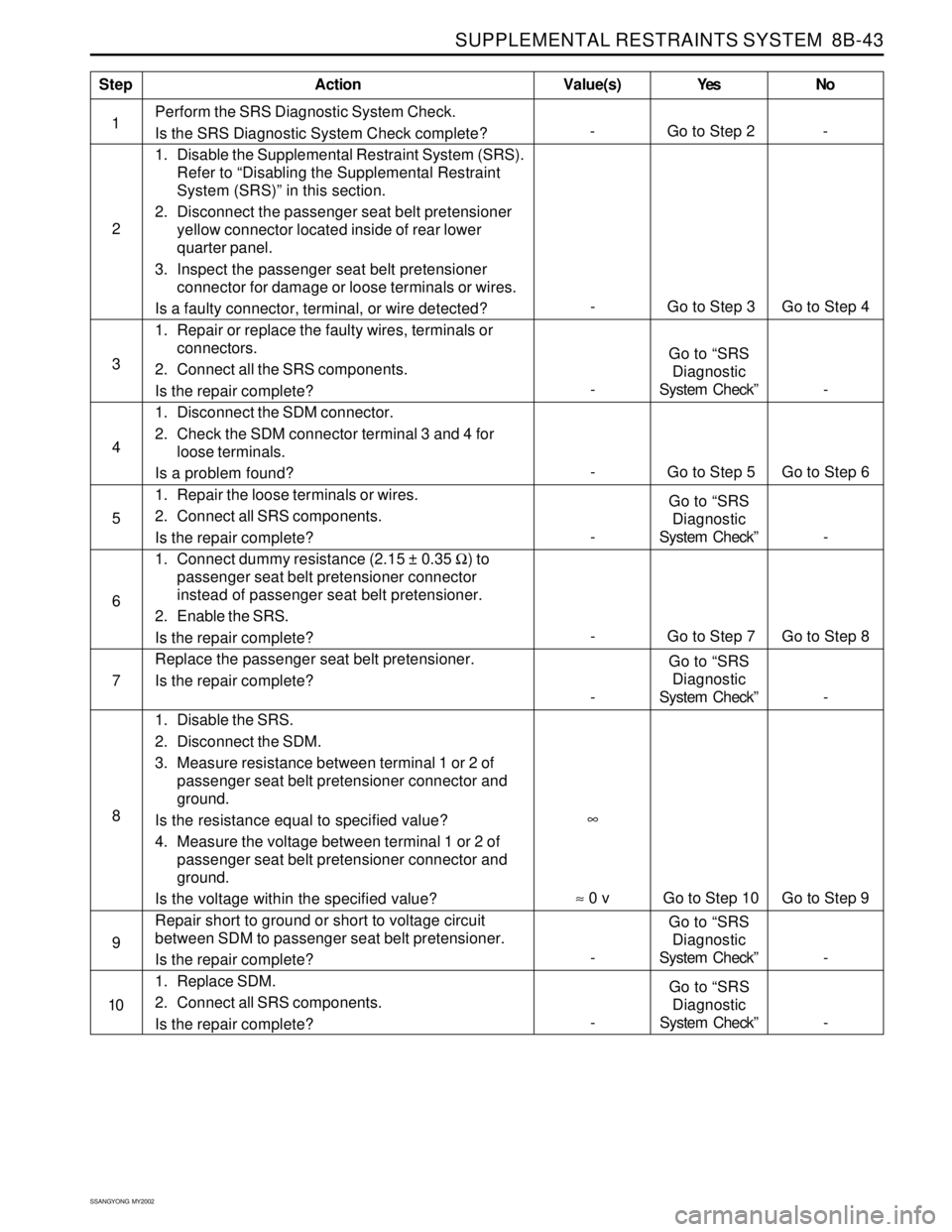
SUPPLEMENTAL RESTRAINTS SYSTEM 8B-43
SSANGYONG MY2002
Perform the SRS Diagnostic System Check.
Is the SRS Diagnostic System Check complete?
1. Disable the Supplemental Restraint System (SRS).
Refer to “Disabling the Supplemental Restraint
System (SRS)” in this section.
2. Disconnect the passenger seat belt pretensioner
yellow connector located inside of rear lower
quarter panel.
3. Inspect the passenger seat belt pretensioner
connector for damage or loose terminals or wires.
Is a faulty connector, terminal, or wire detected?
1. Repair or replace the faulty wires, terminals or
connectors.
2. Connect all the SRS components.
Is the repair complete?
1. Disconnect the SDM connector.
2. Check the SDM connector terminal 3 and 4 for
loose terminals.
Is a problem found?
1. Repair the loose terminals or wires.
2. Connect all SRS components.
Is the repair complete?
1. Connect dummy resistance (2.15 ± 0.35 Ω) to
passenger seat belt pretensioner connector
instead of passenger seat belt pretensioner.
2. Enable the SRS.
Is the repair complete?
Replace the passenger seat belt pretensioner.
Is the repair complete?
1. Disable the SRS.
2. Disconnect the SDM.
3. Measure resistance between terminal 1 or 2 of
passenger seat belt pretensioner connector and
ground.
Is the resistance equal to specified value?
4. Measure the voltage between terminal 1 or 2 of
passenger seat belt pretensioner connector and
ground.
Is the voltage within the specified value?
Repair short to ground or short to voltage circuit
between SDM to passenger seat belt pretensioner.
Is the repair complete?
1. Replace SDM.
2. Connect all SRS components.
Is the repair complete?
StepAction Value(s) Yes No
2
4
5
6
- Go to Step 3 Go to Step 4
3
-Go to “SRS
Diagnostic
System Check” -
- Go to Step 5 Go to Step 6
-Go to “SRS
Diagnostic
System Check” -
-Go to “SRS
Diagnostic
System Check” - 7
8
9
10
-Go to “SRS
Diagnostic
System Check” - 1
- Go to Step 2 -
≈ 0 v Go to Step 10 Go to Step 9∞
- Go to Step 7 Go to Step 8
-Go to “SRS
Diagnostic
System Check” -
Page 1628 of 2053
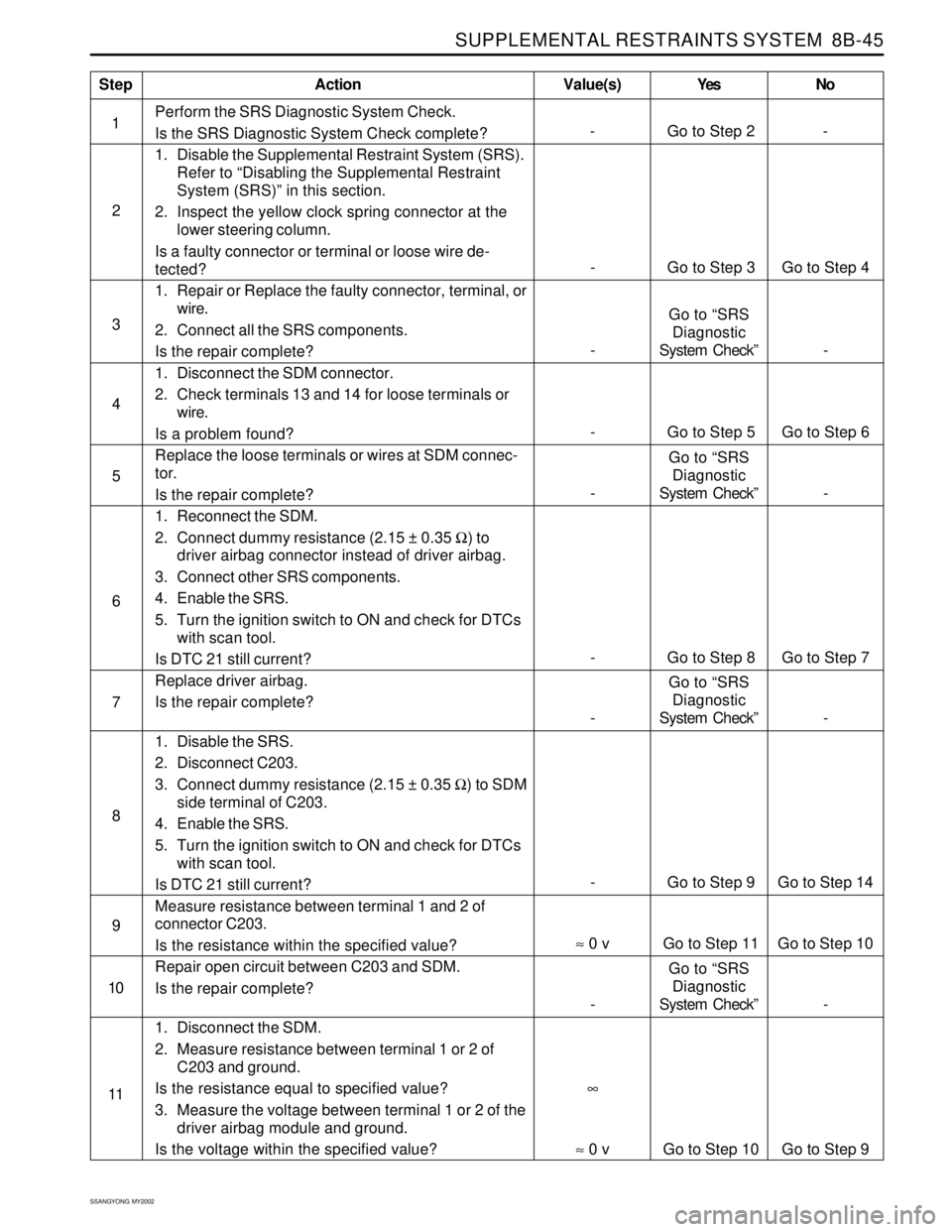
SUPPLEMENTAL RESTRAINTS SYSTEM 8B-45
SSANGYONG MY2002
Perform the SRS Diagnostic System Check.
Is the SRS Diagnostic System Check complete?
1. Disable the Supplemental Restraint System (SRS).
Refer to “Disabling the Supplemental Restraint
System (SRS)” in this section.
2. Inspect the yellow clock spring connector at the
lower steering column.
Is a faulty connector or terminal or loose wire de-
tected?
1. Repair or Replace the faulty connector, terminal, or
wire.
2. Connect all the SRS components.
Is the repair complete?
1. Disconnect the SDM connector.
2. Check terminals 13 and 14 for loose terminals or
wire.
Is a problem found?
Replace the loose terminals or wires at SDM connec-
tor.
Is the repair complete?
1. Reconnect the SDM.
2. Connect dummy resistance (2.15 ± 0.35 Ω) to
driver airbag connector instead of driver airbag.
3. Connect other SRS components.
4. Enable the SRS.
5. Turn the ignition switch to ON and check for DTCs
with scan tool.
Is DTC 21 still current?
Replace driver airbag.
Is the repair complete?
1. Disable the SRS.
2. Disconnect C203.
3. Connect dummy resistance (2.15 ± 0.35 Ω) to SDM
side terminal of C203.
4. Enable the SRS.
5. Turn the ignition switch to ON and check for DTCs
with scan tool.
Is DTC 21 still current?
Measure resistance between terminal 1 and 2 of
connector C203.
Is the resistance within the specified value?
Repair open circuit between C203 and SDM.
Is the repair complete?
1. Disconnect the SDM.
2. Measure resistance between terminal 1 or 2 of
C203 and ground.
Is the resistance equal to specified value?
3. Measure the voltage between terminal 1 or 2 of the
driver airbag module and ground.
Is the voltage within the specified value?
StepAction Value(s) Yes No
2
4
5
6
- Go to Step 3 Go to Step 4
3
-Go to “SRS
Diagnostic
System Check” -
- Go to Step 5 Go to Step 6
-Go to “SRS
Diagnostic
System Check” -
7
8
9
10
-Go to “SRS
Diagnostic
System Check” - 1
- Go to Step 2 -
∞
- Go to Step 8 Go to Step 7
-Go to “SRS
Diagnostic
System Check” -
11
- Go to Step 9 Go to Step 14
≈ 0 v Go to Step 11 Go to Step 10
≈ 0 v Go to Step 10 Go to Step 9
Page 1631 of 2053
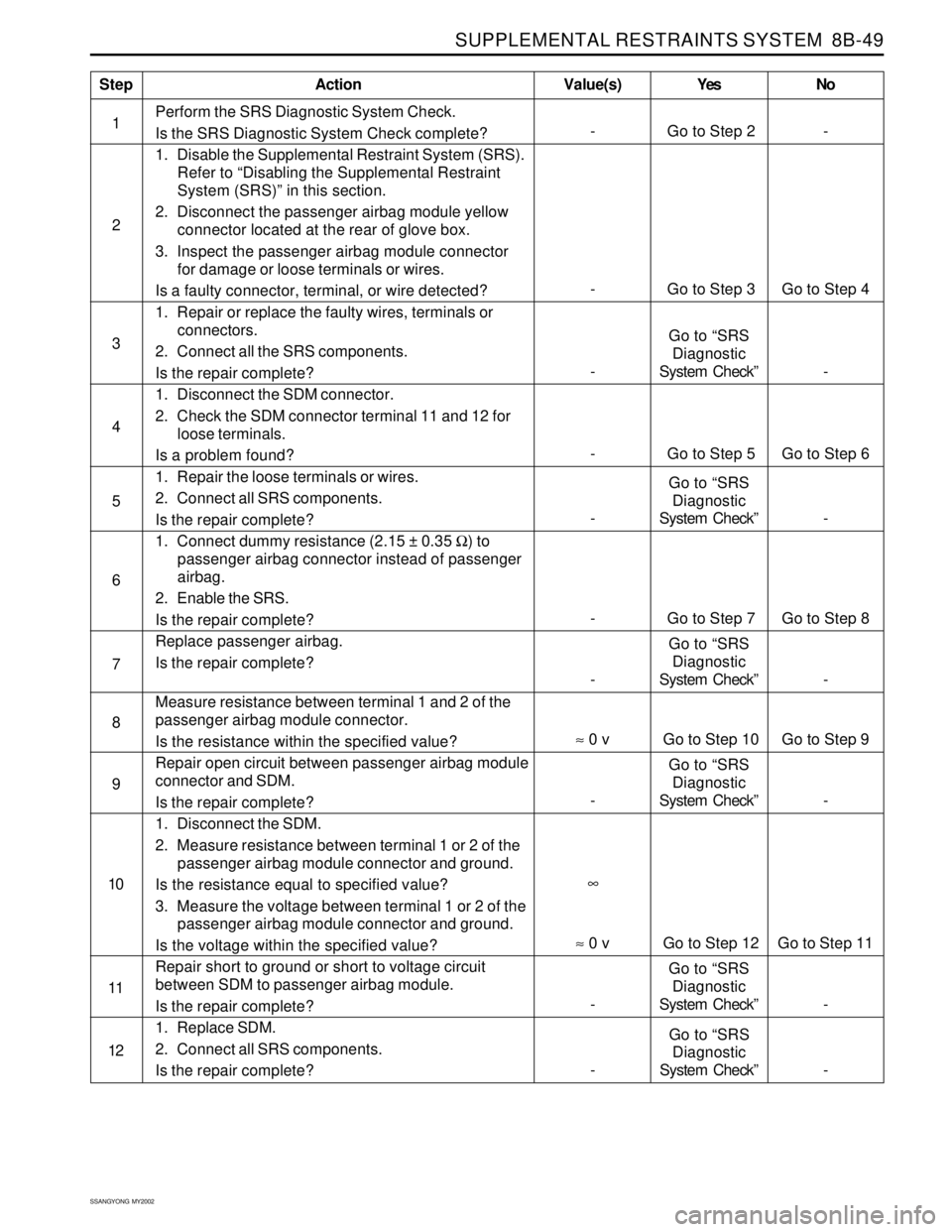
SUPPLEMENTAL RESTRAINTS SYSTEM 8B-49
SSANGYONG MY2002
Perform the SRS Diagnostic System Check.
Is the SRS Diagnostic System Check complete?
1. Disable the Supplemental Restraint System (SRS).
Refer to “Disabling the Supplemental Restraint
System (SRS)” in this section.
2. Disconnect the passenger airbag module yellow
connector located at the rear of glove box.
3. Inspect the passenger airbag module connector
for damage or loose terminals or wires.
Is a faulty connector, terminal, or wire detected?
1. Repair or replace the faulty wires, terminals or
connectors.
2. Connect all the SRS components.
Is the repair complete?
1. Disconnect the SDM connector.
2. Check the SDM connector terminal 11 and 12 for
loose terminals.
Is a problem found?
1. Repair the loose terminals or wires.
2. Connect all SRS components.
Is the repair complete?
1. Connect dummy resistance (2.15 ± 0.35 Ω) to
passenger airbag connector instead of passenger
airbag.
2. Enable the SRS.
Is the repair complete?
Replace passenger airbag.
Is the repair complete?
Measure resistance between terminal 1 and 2 of the
passenger airbag module connector.
Is the resistance within the specified value?
Repair open circuit between passenger airbag module
connector and SDM.
Is the repair complete?
1. Disconnect the SDM.
2. Measure resistance between terminal 1 or 2 of the
passenger airbag module connector and ground.
Is the resistance equal to specified value?
3. Measure the voltage between terminal 1 or 2 of the
passenger airbag module connector and ground.
Is the voltage within the specified value?
Repair short to ground or short to voltage circuit
between SDM to passenger airbag module.
Is the repair complete?
1. Replace SDM.
2. Connect all SRS components.
Is the repair complete?
StepAction Value(s) Yes No
2
4
5
6
- Go to Step 3 Go to Step 4
3
-Go to “SRS
Diagnostic
System Check” -
- Go to Step 5 Go to Step 6
-Go to “SRS
Diagnostic
System Check” -
7
8
9
10
-Go to “SRS
Diagnostic
System Check” - 1
- Go to Step 2 -
∞
- Go to Step 7 Go to Step 8
-Go to “SRS
Diagnostic
System Check” -
11
≈ 0 v Go to Step 10 Go to Step 9
≈ 0 v Go to Step 12 Go to Step 11
-Go to “SRS
Diagnostic
System Check” -
-Go to “SRS
Diagnostic
System Check” - 12
Page 1633 of 2053
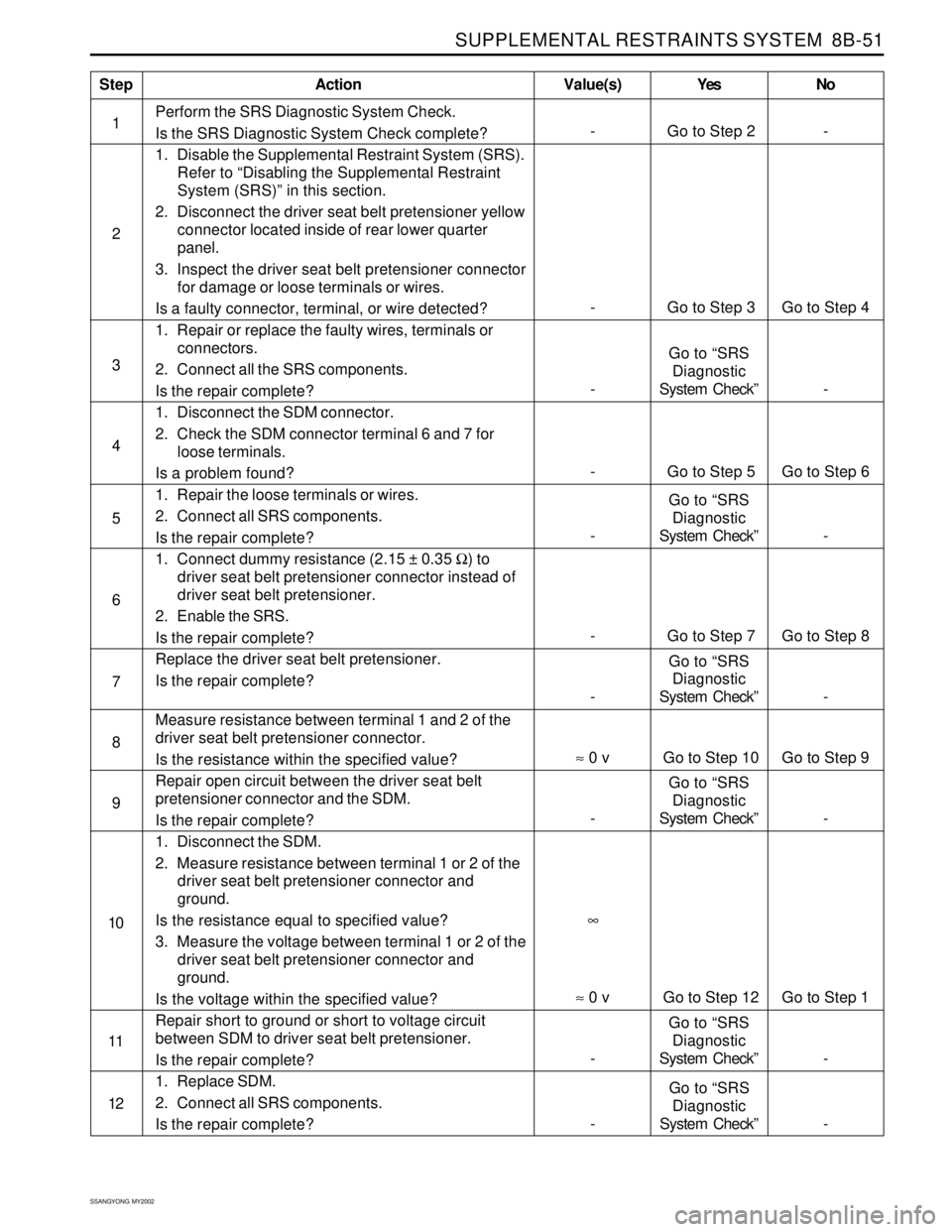
SUPPLEMENTAL RESTRAINTS SYSTEM 8B-51
SSANGYONG MY2002
Perform the SRS Diagnostic System Check.
Is the SRS Diagnostic System Check complete?
1. Disable the Supplemental Restraint System (SRS).
Refer to “Disabling the Supplemental Restraint
System (SRS)” in this section.
2. Disconnect the driver seat belt pretensioner yellow
connector located inside of rear lower quarter
panel.
3. Inspect the driver seat belt pretensioner connector
for damage or loose terminals or wires.
Is a faulty connector, terminal, or wire detected?
1. Repair or replace the faulty wires, terminals or
connectors.
2. Connect all the SRS components.
Is the repair complete?
1. Disconnect the SDM connector.
2. Check the SDM connector terminal 6 and 7 for
loose terminals.
Is a problem found?
1. Repair the loose terminals or wires.
2. Connect all SRS components.
Is the repair complete?
1. Connect dummy resistance (2.15 ± 0.35 Ω) to
driver seat belt pretensioner connector instead of
driver seat belt pretensioner.
2. Enable the SRS.
Is the repair complete?
Replace the driver seat belt pretensioner.
Is the repair complete?
Measure resistance between terminal 1 and 2 of the
driver seat belt pretensioner connector.
Is the resistance within the specified value?
Repair open circuit between the driver seat belt
pretensioner connector and the SDM.
Is the repair complete?
1. Disconnect the SDM.
2. Measure resistance between terminal 1 or 2 of the
driver seat belt pretensioner connector and
ground.
Is the resistance equal to specified value?
3. Measure the voltage between terminal 1 or 2 of the
driver seat belt pretensioner connector and
ground.
Is the voltage within the specified value?
Repair short to ground or short to voltage circuit
between SDM to driver seat belt pretensioner.
Is the repair complete?
1. Replace SDM.
2. Connect all SRS components.
Is the repair complete?
StepAction Value(s) Yes No
2
4
5
6
- Go to Step 3 Go to Step 4
3
-Go to “SRS
Diagnostic
System Check” -
- Go to Step 5 Go to Step 6
-Go to “SRS
Diagnostic
System Check” -
7
8
9
10
-Go to “SRS
Diagnostic
System Check” - 1
- Go to Step 2 -
∞
- Go to Step 7 Go to Step 8
-Go to “SRS
Diagnostic
System Check” -
11
≈ 0 v Go to Step 10 Go to Step 9
≈ 0 v Go to Step 12 Go to Step 1
-Go to “SRS
Diagnostic
System Check” -
-Go to “SRS
Diagnostic
System Check” - 12
Page 1635 of 2053
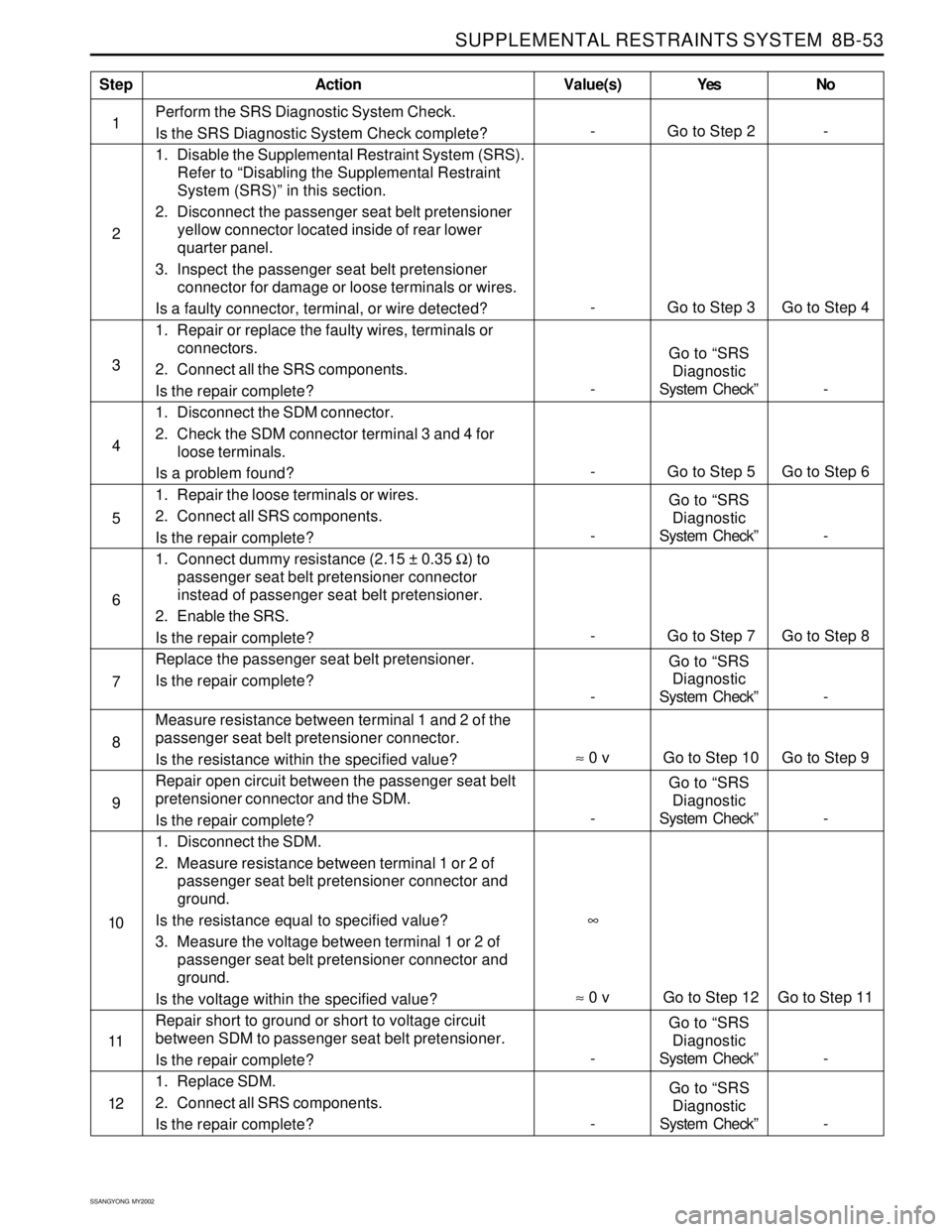
SUPPLEMENTAL RESTRAINTS SYSTEM 8B-53
SSANGYONG MY2002
Perform the SRS Diagnostic System Check.
Is the SRS Diagnostic System Check complete?
1. Disable the Supplemental Restraint System (SRS).
Refer to “Disabling the Supplemental Restraint
System (SRS)” in this section.
2. Disconnect the passenger seat belt pretensioner
yellow connector located inside of rear lower
quarter panel.
3. Inspect the passenger seat belt pretensioner
connector for damage or loose terminals or wires.
Is a faulty connector, terminal, or wire detected?
1. Repair or replace the faulty wires, terminals or
connectors.
2. Connect all the SRS components.
Is the repair complete?
1. Disconnect the SDM connector.
2. Check the SDM connector terminal 3 and 4 for
loose terminals.
Is a problem found?
1. Repair the loose terminals or wires.
2. Connect all SRS components.
Is the repair complete?
1. Connect dummy resistance (2.15 ± 0.35 Ω) to
passenger seat belt pretensioner connector
instead of passenger seat belt pretensioner.
2. Enable the SRS.
Is the repair complete?
Replace the passenger seat belt pretensioner.
Is the repair complete?
Measure resistance between terminal 1 and 2 of the
passenger seat belt pretensioner connector.
Is the resistance within the specified value?
Repair open circuit between the passenger seat belt
pretensioner connector and the SDM.
Is the repair complete?
1. Disconnect the SDM.
2. Measure resistance between terminal 1 or 2 of
passenger seat belt pretensioner connector and
ground.
Is the resistance equal to specified value?
3. Measure the voltage between terminal 1 or 2 of
passenger seat belt pretensioner connector and
ground.
Is the voltage within the specified value?
Repair short to ground or short to voltage circuit
between SDM to passenger seat belt pretensioner.
Is the repair complete?
1. Replace SDM.
2. Connect all SRS components.
Is the repair complete?
StepAction Value(s) Yes No
2
4
5
6
- Go to Step 3 Go to Step 4
3
-Go to “SRS
Diagnostic
System Check” -
- Go to Step 5 Go to Step 6
-Go to “SRS
Diagnostic
System Check” -
7
8
9
10
-Go to “SRS
Diagnostic
System Check” - 1
- Go to Step 2 -
∞
- Go to Step 7 Go to Step 8
-Go to “SRS
Diagnostic
System Check” -
11
≈ 0 v Go to Step 10 Go to Step 9
≈ 0 v Go to Step 12 Go to Step 11
-Go to “SRS
Diagnostic
System Check” -
-Go to “SRS
Diagnostic
System Check” - 12
Page 1637 of 2053
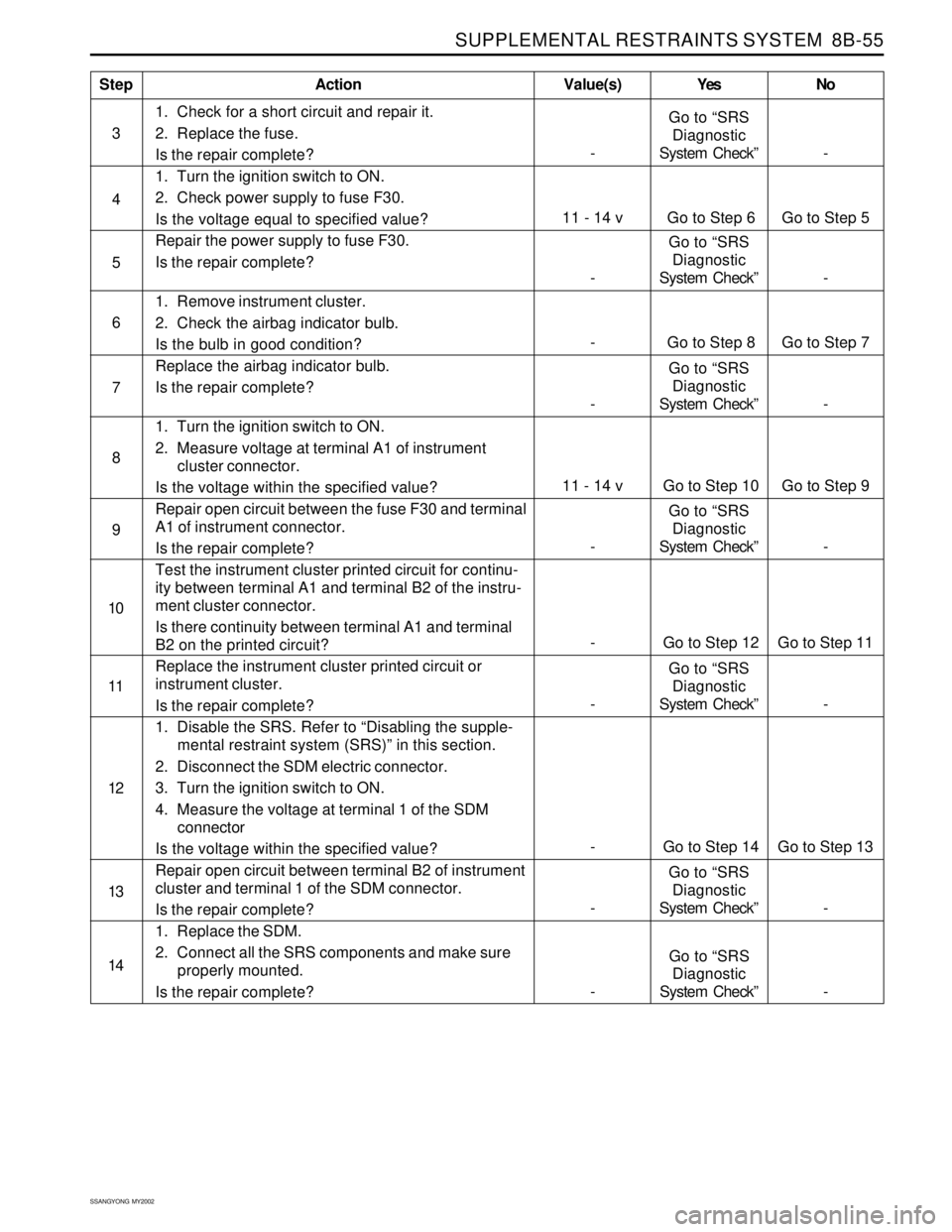
SUPPLEMENTAL RESTRAINTS SYSTEM 8B-55
SSANGYONG MY2002
1. Check for a short circuit and repair it.
2. Replace the fuse.
Is the repair complete?
1. Turn the ignition switch to ON.
2. Check power supply to fuse F30.
Is the voltage equal to specified value?
Repair the power supply to fuse F30.
Is the repair complete?
1. Remove instrument cluster.
2. Check the airbag indicator bulb.
Is the bulb in good condition?
Replace the airbag indicator bulb.
Is the repair complete?
1. Turn the ignition switch to ON.
2. Measure voltage at terminal A1 of instrument
cluster connector.
Is the voltage within the specified value?
Repair open circuit between the fuse F30 and terminal
A1 of instrument connector.
Is the repair complete?
Test the instrument cluster printed circuit for continu-
ity between terminal A1 and terminal B2 of the instru-
ment cluster connector.
Is there continuity between terminal A1 and terminal
B2 on the printed circuit?
Replace the instrument cluster printed circuit or
instrument cluster.
Is the repair complete?
1. Disable the SRS. Refer to “Disabling the supple-
mental restraint system (SRS)” in this section.
2. Disconnect the SDM electric connector.
3. Turn the ignition switch to ON.
4. Measure the voltage at terminal 1 of the SDM
connector
Is the voltage within the specified value?
Repair open circuit between terminal B2 of instrument
cluster and terminal 1 of the SDM connector.
Is the repair complete?
1. Replace the SDM.
2. Connect all the SRS components and make sure
properly mounted.
Is the repair complete?
StepAction Value(s) Yes No
4
6
7
8
11 - 14 v Go to Step 6 Go to Step 5
5
-Go to “SRS
Diagnostic
System Check” -
- Go to Step 8 Go to Step 7
-Go to “SRS
Diagnostic
System Check” -
9
10
11
12
-Go to “SRS
Diagnostic
System Check” - 3
11 - 14 v Go to Step 10 Go to Step 9
-Go to “SRS
Diagnostic
System Check” -
13
- Go to Step 12 Go to Step 11
- Go to Step 14 Go to Step 13
-Go to “SRS
Diagnostic
System Check” -
-Go to “SRS
Diagnostic
System Check” - 14
-Go to “SRS
Diagnostic
System Check” -
Page 1640 of 2053
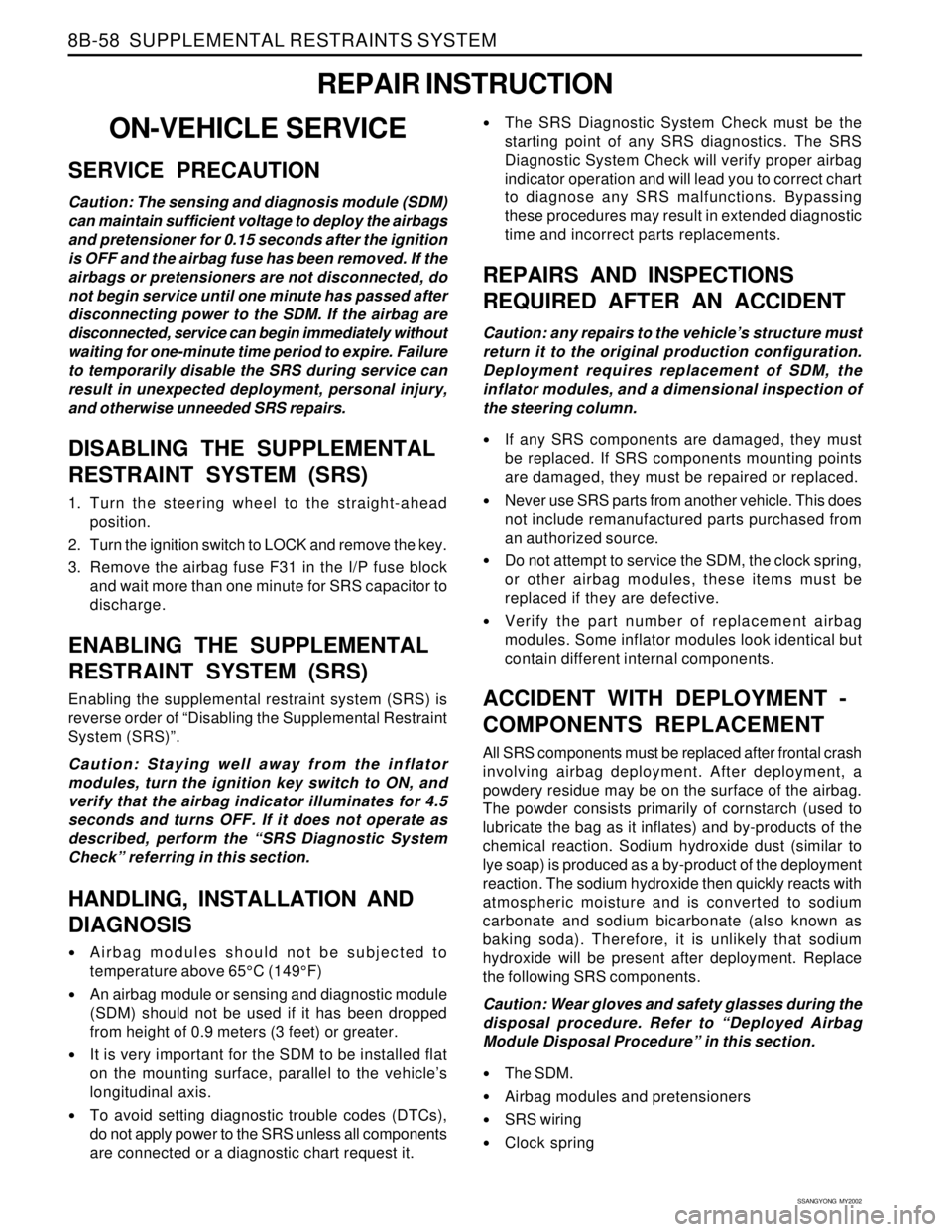
SSANGYONG MY2002
8B-58 SUPPLEMENTAL RESTRAINTS SYSTEM
REPAIR INSTRUCTION
ON-VEHICLE SERVICE
SERVICE PRECAUTION
Caution: The sensing and diagnosis module (SDM)
can maintain sufficient voltage to deploy the airbags
and pretensioner for 0.15 seconds after the ignition
is OFF and the airbag fuse has been removed. If the
airbags or pretensioners are not disconnected, do
not begin service until one minute has passed after
disconnecting power to the SDM. If the airbag are
disconnected, service can begin immediately without
waiting for one-minute time period to expire. Failure
to temporarily disable the SRS during service can
result in unexpected deployment, personal injury,
and otherwise unneeded SRS repairs.
DISABLING THE SUPPLEMENTAL
RESTRAINT SYSTEM (SRS)
1. Turn the steering wheel to the straight-ahead
position.
2. Turn the ignition switch to LOCK and remove the key.
3. Remove the airbag fuse F31 in the I/P fuse block
and wait more than one minute for SRS capacitor to
discharge.
ENABLING THE SUPPLEMENTAL
RESTRAINT SYSTEM (SRS)
Enabling the supplemental restraint system (SRS) is
reverse order of “Disabling the Supplemental Restraint
System (SRS)”.
Caution: Staying well away from the inflator
modules, turn the ignition key switch to ON, and
verify that the airbag indicator illuminates for 4.5
seconds and turns OFF. If it does not operate as
described, perform the “SRS Diagnostic System
Check” referring in this section.
HANDLING, INSTALLATION AND
DIAGNOSIS
Airbag modules should not be subjected to
temperature above 65°C (149°F)
An airbag module or sensing and diagnostic module
(SDM) should not be used if it has been dropped
from height of 0.9 meters (3 feet) or greater.
It is very important for the SDM to be installed flat
on the mounting surface, parallel to the vehicle’s
longitudinal axis.
To avoid setting diagnostic trouble codes (DTCs),
do not apply power to the SRS unless all components
are connected or a diagnostic chart request it.
The SRS Diagnostic System Check must be the
starting point of any SRS diagnostics. The SRS
Diagnostic System Check will verify proper airbag
indicator operation and will lead you to correct chart
to diagnose any SRS malfunctions. Bypassing
these procedures may result in extended diagnostic
time and incorrect parts replacements.
REPAIRS AND INSPECTIONS
REQUIRED AFTER AN ACCIDENT
Caution: any repairs to the vehicle’s structure must
return it to the original production configuration.
Deployment requires replacement of SDM, the
inflator modules, and a dimensional inspection of
the steering column.
If any SRS components are damaged, they must
be replaced. If SRS components mounting points
are damaged, they must be repaired or replaced.
Never use SRS parts from another vehicle. This does
not include remanufactured parts purchased from
an authorized source.
Do not attempt to service the SDM, the clock spring,
or other airbag modules, these items must be
replaced if they are defective.
Verify the part number of replacement airbag
modules. Some inflator modules look identical but
contain different internal components.
ACCIDENT WITH DEPLOYMENT -
COMPONENTS REPLACEMENT
All SRS components must be replaced after frontal crash
involving airbag deployment. After deployment, a
powdery residue may be on the surface of the airbag.
The powder consists primarily of cornstarch (used to
lubricate the bag as it inflates) and by-products of the
chemical reaction. Sodium hydroxide dust (similar to
lye soap) is produced as a by-product of the deployment
reaction. The sodium hydroxide then quickly reacts with
atmospheric moisture and is converted to sodium
carbonate and sodium bicarbonate (also known as
baking soda). Therefore, it is unlikely that sodium
hydroxide will be present after deployment. Replace
the following SRS components.
Caution: Wear gloves and safety glasses during the
disposal procedure. Refer to “Deployed Airbag
Module Disposal Procedure” in this section.
The SDM.
Airbag modules and pretensioners
SRS wiring
Clock spring
Page 1641 of 2053
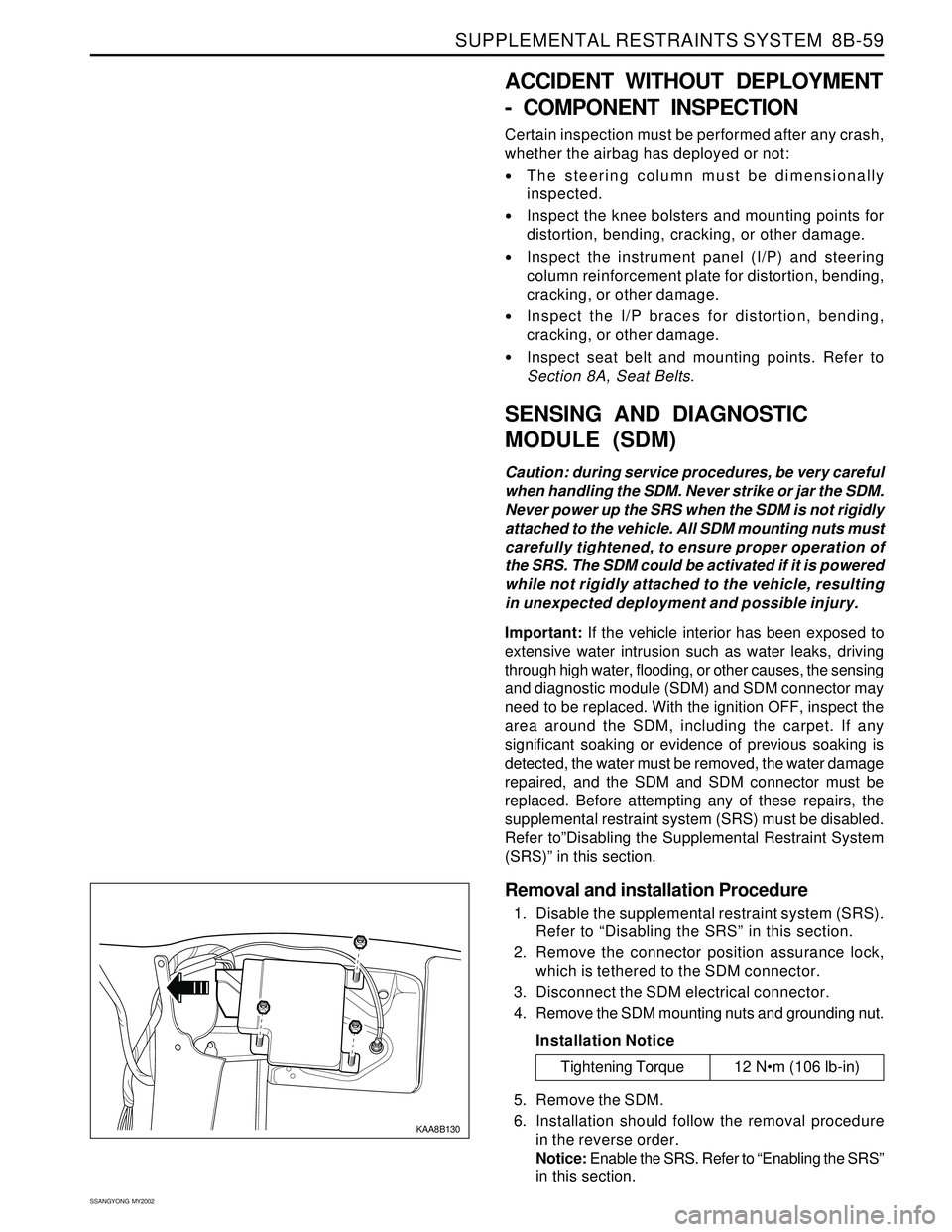
SUPPLEMENTAL RESTRAINTS SYSTEM 8B-59
SSANGYONG MY2002
KAA8B130
ACCIDENT WITHOUT DEPLOYMENT
- COMPONENT INSPECTION
Certain inspection must be performed after any crash,
whether the airbag has deployed or not:
The steering column must be dimensionally
inspected.
Inspect the knee bolsters and mounting points for
distortion, bending, cracking, or other damage.
Inspect the instrument panel (I/P) and steering
column reinforcement plate for distortion, bending,
cracking, or other damage.
Inspect the I/P braces for distortion, bending,
cracking, or other damage.
Inspect seat belt and mounting points. Refer to
Section 8A, Seat Belts.
SENSING AND DIAGNOSTIC
MODULE (SDM)
Caution: during service procedures, be very careful
when handling the SDM. Never strike or jar the SDM.
Never power up the SRS when the SDM is not rigidly
attached to the vehicle. All SDM mounting nuts must
carefully tightened, to ensure proper operation of
the SRS. The SDM could be activated if it is powered
while not rigidly attached to the vehicle, resulting
in unexpected deployment and possible injury.
Important: If the vehicle interior has been exposed to
extensive water intrusion such as water leaks, driving
through high water, flooding, or other causes, the sensing
and diagnostic module (SDM) and SDM connector may
need to be replaced. With the ignition OFF, inspect the
area around the SDM, including the carpet. If any
significant soaking or evidence of previous soaking is
detected, the water must be removed, the water damage
repaired, and the SDM and SDM connector must be
replaced. Before attempting any of these repairs, the
supplemental restraint system (SRS) must be disabled.
Refer to”Disabling the Supplemental Restraint System
(SRS)” in this section.
Removal and installation Procedure
1. Disable the supplemental restraint system (SRS).
Refer to “Disabling the SRS” in this section.
2. Remove the connector position assurance lock,
which is tethered to the SDM connector.
3. Disconnect the SDM electrical connector.
4. Remove the SDM mounting nuts and grounding nut.
Installation Notice
5. Remove the SDM.
6. Installation should follow the removal procedure
in the reverse order.
Notice: Enable the SRS. Refer to “Enabling the SRS”
in this section.
Tightening Torque 12 Nm (106 lb-in)